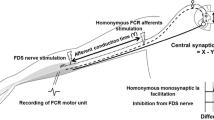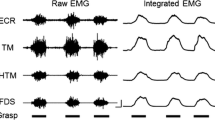Summary
The two long toe flexor muscles in the cat, flexor digitorum longus (FDL) and flexor hallucis longus (FHL), have essentially identical mechanical actions, yet are used very differently during locomotion (O'Donovan et al. 1982). We attempted to identify the origin of the synaptic drive responsible for this functional differentiation.
The organization of peripheral and central synaptic drive to FDL and FHL motoneurons was examined using two basic paradigms. (1) In animals anesthetized with chloralose or after ischemic destruction of the brain, peripheral reflex circuits were studied by recording intracellular responses from α-motoneurons produced by electrical stimulation of muscular and cutaneous nerves. (2) “Fictive locomotion”, the centrally generated rhythmic synaptic drive produced in paralyzed, decerebrate animals by stimulation of the mesencephalic locomotor region or intravenous injection of L-DOPA and Nialamide, was monitored by recording electro-neurograms from the central end of cut motor nerves.
Despite their functional dissimilarity, FDL and FHL motoneurons received monosynaptic EPSPs from both FDL and FHL la afferents. Ipsilateral cutaneous afferents in the sural nerve and from the central plantar pad produced multiphasic PSPs which were not different in FDL and FHL cells. However afferents from the saphenous and superficial peroneal nerves did exert differential effects: the first component of the multiphasic PSP in most FDL cells was an EPSP, which was not present in most FHL cells. The central latency of this early EPSP in FDL motoneurons (0.8–1.5 ms) strongly suggests a disynaptic linkage. Cutaneous afferents from the ipsilateral forelimb produced IPSPs in most FHL cells but in only one of 18 FDL cells. Since some peripheral reflex circuits exerted differential effects on FDL and FHL cells, but others did not, the intracellular data did not demonstrate that the functional differences between FDL and FHL could be explained by differences in reflex organization.
During fictive locomotion elicited by electrical or pharmacological stimulation, FHL motoneurons were coactive with ankle extensors during the extension phase of the fictive step cycle. In contrast, FDL motoneurons were most consistently activated in a brief burst at the onset of the flexion phase, showing much weaker and more variable coactivity with ankle extensors. These patterns were essentially identical to those reported for FDL and FHL motor pools during treadmill locomotion by O'Donovan et al. (1982).
We conclude that the central pattern generator (CPG) for locomotion produces distinct and highly differentiated sets of instructions for FDL and FHL motoneurons. Peripheral and descending systems are important in initiating and biasing the activity of the CPG, but are not responsible for the intrinsic structure of the locomotor command signals.
Similar content being viewed by others
References
Andersson O, Grillner S, Lindquist M, Zomlefer M (1978) Peripheral control of the spinal pattern generators for locomotion in cat. Brain Res 150: 625–630
Aoki M, McIntyre AK (1975) Cortical and long spinal actions on lumbosacral motoneurones in the cat. J Physiol (Lond) 251: 569–587
Baldissera F, Hultborn H, Illert M (1981) Integration in spinal neuronal systems. In: Brooks VB (ed) Handbook of physiology, Sect 1.The nervous system, vol II. Motor control, Part 1. American Physiological Society, Bethesda, pp 509–595
Bayev KV (1978) Central locomotor program for the cat's hindlimb. Neurosci 3: 1081–1092
Bernhard CG (1953) The spinal cord potentials in leads from the cord dorsum in relation to peripheral source of afferent stimulation. Acta Physiol Scand 29: Suppl. 106
Burke RE (1981) Motor units: anatomy, physiology, and functional organization. In: Brooks VB (ed) Handbook of physiology, Sect 1. The nervous system, vol II. Motor control, Part 1. American Physiological Society, Bethesda, pp 345–422
Burke RE, Jankowska E, ten Bruggencate G (1970) A comparison of peripheral and rubrospinal synaptic input to slow and fast twitch motor units of triceps surae. J Physiol (Lond) 207: 709–732
Burke RE, Rymer WZ, Walsh Jr JV (1973) Functional specialization in the motor unit population of cat medial gastrocnemius muscle. In: Stein RB, Pearson KG, Smith RS, Redford JB (eds) Control of posture and locomotion. Plenum, New York, pp 29–44
Coombs JS, Eccles JC, Fatt P (1955) The specific ionic conductances and the ionic movements across the motoneuronal membrane that produce the inhibitory post-synaptic potential. J Physiol (Lond) 130: 326–373
Cullheim S, Kellerth J-O (1978) A morphological study of the axons and recurrent axon collaterals of cat α-motoneurones supplying different hind-limb muscles. J Physiol (Lond) 281: 285–299
Denny-Brown D (1932) Description and analysis of the residual ipsilateral extension reflex. In: Creed RS, Denny-Brown D, Eccles JC, Liddell EGT, Sherrington CS (eds) Reflex activity of the spinal cord. Oxford, London, pp 73–83
Dum RP, Burke RE, O'Donovan MJ, Toop J, Hodgson JA (1982) Motor-unit organization in flexor digitorum longus muscle of the cat. J Neurophysiol 47: 1108–1125
Duysens J (1977) Reflex control of locomotion as revealed by stimulation of cutaneous afferents in spontaneously walking premammillary cats. J Neurophysiol 40: 737–751
Duysens J, Loeb GE (1980) Modulation of ipsi- and contralateral reflex responses in unrestrained walking cats. J Neurophysiol 44: 1024–1037
Duysens J, Pearson KG (1976) The role of cutaneous afferents from the distal hindlimb in the regulation of the step cycle of thalamic cats. Exp Brain Res 24: 245–255
Eccles JC, Eccles RM, Lundberg A (1957) The convergence of monosynaptic excitatory afferents onto many different species of alpha motoneurones. J Physiol (Lond) 137: 22–50
Eccles RM, Lundberg A (1959) Synaptic actions in motoneurones by afferents which may evoke the flexion reflex. Arch Ital Biol 97: 199–221
Edgerton VR, Grillner S, Sjostrom A, Zangger P (1976) Central generation of locomotion in vertebrates. In: Herman RM, Grillner S, Stein PSG, Stuart DG (eds) Neural control of locomotion. Plenum, New York, pp. 439–464
Engberg I (1964) Reflexes to foot muscles in the cat. Acta Physiol Scand 62: Suppl. 235
Engberg I, Lundberg A (1969) An electromyographic analysis of muscular activity in the hindlimb of the cat during unrestrained locomotion. Acta Physiol Scand 75: 614–630
Fleshman JW, Lev-Tov A, Burke RE (1981) Synaptic organization in FDL and FHL motor nuclei: a search for mechanisms underlying the functional disparity in strict anatomical synergists. Soc Neurosci Abstr 7: 689
Forssberg H (1979) Stumbling corrective reaction: a phase-dependent compensatory reaction during locomotion. J Neurophysiol 42: 936–953
Goslow Jr GE, Stauffer EK, Nemeth WC, Stuart DG (1972) Digit flexor muscles in the cat: their action and motor units. J Morph 137: 335–352
Graham Brown T, Sherrington CS (1912) The rule of reflex response in the limb reflexes of the mammal and its exceptions. J Physiol (Lond) 44: 125–130
Grillner S (1969) The influence of DOPA on the static and the dynamic fusimotor activity to the triceps surae of the spinal cat. Acta Physiol Scand 77: 490–509
Grillner S (1981) Control of locomotion in biped, tetrapods, and fish. In: Brooks VB (ed) Handbook of physiology, Sect 1. The nervous system, vol II. Motor control, Part 2. American Physiological Society, Bethesda, pp 1179–1236
Grillner S, Shik ML (1973) On the descending control of the lumbosacral spinal cord from the “mesencephalic locomotor region”. Acta Physiol Scand 87: 320–333
Grillner S, Zangger P (1975) How detailed is the central pattern generation for locomotion. Brain Res 88: 367–371
Grillner S, Zangger P (1979) On the central generation of locomotion in the low spinal cat. Exp Brain Res 34: 241–261
Hagbarth K-E (1952) Excitatory and inhibitory skin areas for flexor and extensor motoneurones. Acta Physiol Scand 26: Suppl 94
Hongo T, Jankowska E, Lundberg A (1969a) The rubrospinal tract. I. Effects on alpha-motoneurones innervating hindlimb muscles in cats. Exp Brain Res 7: 344–364
Hongo T, Jankowska E, Lundberg A (1969b) The rubrospinal tract. II. Facilitation of interneuronal transmission in reflex paths to motoneurones. Exp Brain Res 7: 365–391
Illert M, Lundberg A, Tanaka R (1976) Integration in descending motor pathways controlling the forelimb in the cat. 2. Convergence on neurones mediating disynaptic corticomoto-neuronal excitation. Exp Brain Res 26: 521–540
Jankowska E, Jukes MGM, Lund S, Lundberg A (1967a) The effect of DOPA on the spinal cord. 5. Reciprocal organization of pathways transmitting excitatory action to alpha moto-neurones of flexors and extensors. Acta Physiol Scand 70: 369–388
Jankowska E, Jukes MGM, Lund S, Lundberg A (1967b) The effect of DOPA on the spinal cord. 6. Half-centre organization of interneurones transmitting effects from the flexor reflex afferents. Acta Physiol Scand 70: 389–402
Lloyd DPC (1946) Integrative pattern of excitation and inhibition in two-neuron reflex arcs. J Neurophysiol 9: 439–444
Lloyd DPC, McIntyre AK (1948) Analysis of forelimb-hindlimb reflex activity in acutely decapitate cats. J Neurophysiol 11: 455–70
Lundberg A (1969) Reflex control of stepping. The Nansen Memorial Lecture V. Oslo, Universitetsforlaget, pp 1–42
Lundberg A (1975) The control of spinal mechanisms from the brain. In: Brady RO (ed) The nervous system, vol 1. The basic neurosciences. Raven Press, New York, pp 253–265
O'Donovan M, Pinter MJ, Dum RP, Burke RE (1982) Actions of FDL and FHL muscles in intact cats: functional dissociation between anatomical synergists. J Neurophysiol 47: 1126–1143
Orlovsky GN, Fel'dman AG (1972) Role of afferent activity in the generation of stepping movements. J Neurophysiol 4: 304–310
Perret C, Cabelguen J-M (1980) Main characteristics of the hindlimb locomotor cycle in the decorticate cat with special reference to bifunctional muscles. Brain Res 187: 333–352
Pinter MJ, Burke RE, O'Donovan MJ, Dum RP (1982) Supraspinal facilitation of cutaneous polysynaptic EPSPs in cat medial gastrocnemius motoneurons. Exp Brain Res 45: 133–143
Schomburg ED, Behrends H-B, Steffens H (1981) Changes in segmental and propriospinal reflex pathways during spinal locomotion. In: Taylor A, Prochazka A (eds) Muscle receptors and movement. MacMillan, London, pp 413–425
Schomberg ED, Meinck H-M, Haustein J, Roesler J (1978) Functional organization of the spinal reflex pathways from forelimb afferents to hindlimb motoneurons in the cat. Brain Res 139: 21–33
Schomburg ED, Roesler J, Meinck H-M (1977) Phase-dependent transmission in the excitatory propriospinal reflex pathway from forelimb afferents to lumbar motoneurones during fictive locomotion. Neurosci Lett 4: 249–252
Segev I, Parnas I (1983) Synaptic integration mechanisms: Theoretical and experimental investigation of temporal post-synaptic interactions between excitatory and inhibitory inputs. Biophys J 41: 41–50
Sherrington CS (1910) Flexion-reflex of the limb, crossed extension reflex, and reflex stepping and standing. J Physiol (Lond) 40: 28–121
Shik ML, Severin FV, Orlovskii GN (1966) Control of walking and running by means of electrical stimulation of the mid-brain. Biophysics 11: 756–765
Vidal C, Viala D, Buser P (1979) Central locomotor programming in the rabbit. Brain Res 168: 57–73
Willis, Jr WD (1980) Spinal cord potentials. In: Windle WF (ed) The spinal cord and its reaction to traumatic injury. Marcel Dekker, New York, pp 159–187
Winer BJ (1971) Statistical principles in experimental design (2nd ed). McGraw-Hill, New York, p 907
Author information
Authors and Affiliations
Rights and permissions
About this article
Cite this article
Fleshman, J.W., Lev-Tov, A. & Burke, R.E. Peripheral and central control of flexor digitorum longus and flexor hallucis longus motoneurons: The synaptic basis of functional diversity. Exp Brain Res 54, 133–149 (1984). https://doi.org/10.1007/BF00235825
Received:
Issue Date:
DOI: https://doi.org/10.1007/BF00235825




